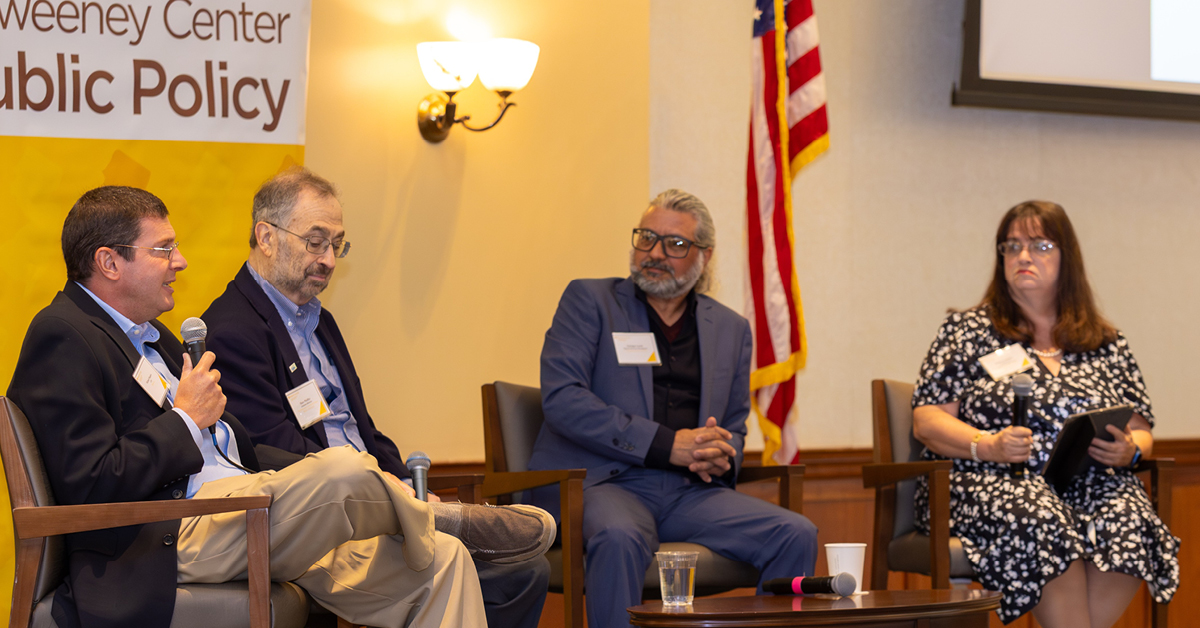Experts explore challenges, opportunities and public interest in the field of journalism at Sweeney Center conference
Experts explore challenges, opportunities and public interest in the field of journalism at Sweeney Center conference

Reporters, editors and media company leaders addressed issues that range from pivoting to digital-first formats to rebuilding trust in today’s journalism industry during “The Future of Journalism: New Models, Digital Transformation and the Public Interest,” a recent conference at Rowan University.
“Every time I see a reporter in their 20s getting in the face of some elected official and following up with questions that make that politician squirm, I feel just a little bit of hope,” David Cruz, NJTV News senior correspondent, said at the conference last month, hosted by the Steve Sweeney Center for Public Policy and the Rowan University Department of Journalism.
Speaking from 30-plus years of news experience, Cruz voiced hope despite what he called “irreversible” challenges in the industry, including the shrinking readership of legacy media, disinformation in the current media landscape and a lack of resources to cover political news.
Digital transformations
A major focus of speakers at the conference was the shift to digital formats in news media.
Over the last two decades, technological changes have been one of the driving factors of evolution in the field of journalism, according to Ken Herts, chief operating officer of The Lenfest Institute for Journalism. Despite shifts in popularity between traditional media and digital media, Herts named numerous “major market metros that have successfully been transitioning from print to digital.”
Enrique Lavin, editor of online newspapers at NJ Advance Media and The Star-Ledger, recalled training every journalist on staff to be “digital-first journalists” as early as 2012.
“We trained everybody to understand what the reality of the future was going to be, which was a 24-hour news cycle that readers would expect to find on the website,” he said.
Nonprofit business models and collaboration
While the majority of newspapers in the U.S. are owned by hedge funds, nonprofit ownership is on the rise, as multiple speakers at the conference discussed.
Instead of chasing profits, Herts said, in nonprofit-owned news organizations, “you can break even, reinvest in the business and aim at community support.”
“The rise in collaboration in journalism has definitely paralleled the rise in nonprofit journalism,” said Stefanie Murray, executive director of the Center for Cooperative Media at Montclair State University. “We should all be working together to get people the information they need to live their lives.”
Making a nonprofit newspaper a sustainable venture requires a diversified revenue stream, according to Amanda Richardson, executive director of the Corporation for New Jersey Local Media.
“We're really focused on improving the digital experience, so our model that we’re working towards is to be able to use our advertising and subscription revenue to support the day-to-day operations of our newspapers while we use the other income streams, like grants and philanthropy, to focus on how we can improve our website and get more people subscribing digitally,” Richardson said.
Serving the public interest
While panelists agreed that journalism should serve the public interest, they acknowledged that this goal means different things to different people.
“We try to help people make better decisions about how to do business and how to shop and inform them so that they can go to the ballot box and choose the person that’s going to help them,” Lavin said.
Marc Pfeiffer, associate director of the Bloustein Local Government Research Center at Rutgers University, stressed the importance of journalism’s role as a government watchdog.
“I have seen firsthand what happens when reporters don’t cover local governments. You get local government officials who make bad choices, they make unethical choices, and, in some cases, they make corrupt choices,” said Pfeiffer, author of “The Future of New Jersey Journalism: Evolution, Not Extinction.”
“For me, public interest is what concerns the audience and public service journalism,” said P. Kenneth Burns, New Jersey reporter for WHYY and NPR and president of the New Jersey Society of Professional Journalists, noting that examples range from what’s happening in town meetings to road closures and increases in beach tag costs.
“We try to help people make better decisions about how to do business and how to shop and inform them so that they can go to the ballot box and choose the person that’s going to help them,” Lavin said.
Chris Daggett, consultant to the New Jersey Civic Information Consortium, discussed the importance of public funding for local news in serving traditionally underserved communities.
“Our main focus is on marginalized communities and news deserts,” Daggett said. “What I like to focus on is equity in terms of people’s ability to have access to news.”
“Distrust of the media is probably one of the biggest hurdles that we face today,” said Terrence McDonald, editor at the nonprofit New Jersey Monitor, noting that a large segment of the population “thinks that the media, from top to bottom, is just corrupt.”
Some of that distrust is deserved, according to Daggett.
“People have been very biased in their reporting, or they have been inaccurate in their reporting,” Daggett said. “Once you lose trust, it’s hard to build it back.”
“The more that we can do as a media organization to build trust, the better, and it starts with complete and open transparency with the reader,” said Michael M. Shapiro, founder and CEO of free online local news source TapInto.net.
“When we make mistakes, we’re the first to try to correct it as soon as possible because we want you to trust us,” Lavin said. “And now, in the digital age, we can correct it immediately.”
Sweeney Center Director Mark Magyar, Rowan Journalism Department Chair Kathryn Quigley and Associate Professor of Journalism Dianne Garyantes served as moderators for the conference.